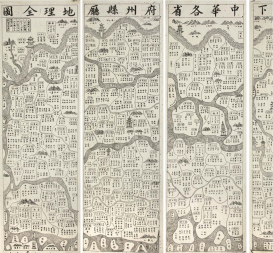This project investigates a group of six Chinese maps, presumably dating from the nineteenth to twentieth century, acquired by the MPIWG in 2016 from the Floyd Sully collection (Walter Davis 2015). Evidence of cosmographical connotations and traces of early spatial concepts may be manifested through topographically inaccurate schematic configuration of the mapped territory and the presence of legendary or out-dated, but cosmographically significant landmarks. Especially interesting in this respect is an “archaic-looking” Da Qing Tianxia Zhonghua ge sheng fu zhou xian ting dili quantu 大清天下中華 各省府州縣廳 地理全圖 (Complete Terrestrial Organisation Map of the Great Qing’s Under-Heaven and the Central Florescence with all the provinces, prefectures, districts, counties and sub-prefectures), whose attribution and dating needs to be established.
Particular attention will be paid to the map titles, whose significance is rarely taken into consideration and for which translations are often imprecise. I became interested in map titles with the re-discovery in the SUB Göttingen of the unique manuscript map drawn by Taoist master and astronomer Li Mingche 李明徹 (1751–1832)—the Da Qing wannian yitong jingwei yutu大清萬年一統 經緯輿圖 (Comprehensive Map with the Longitude & Latitude Grid of the Great Qing Everlastingly Unified). The map’s title consists of both the map content and the map type. One of the maps acquired by the MPIWG belongs to the same content category and will be studied in relation to the Göttingen map. I assume that the names of Chinese maps provide indicators to their classification in the Chinese cartographical tradition, and shall discuss the MPIWG maps’ titles from this perspective.
The proposed approach allows a more profound attribution of the MPIWG maps. This project is pursued in cooperation with YANG Yulei 楊雨蕾, who explores different aspects of these maps.

